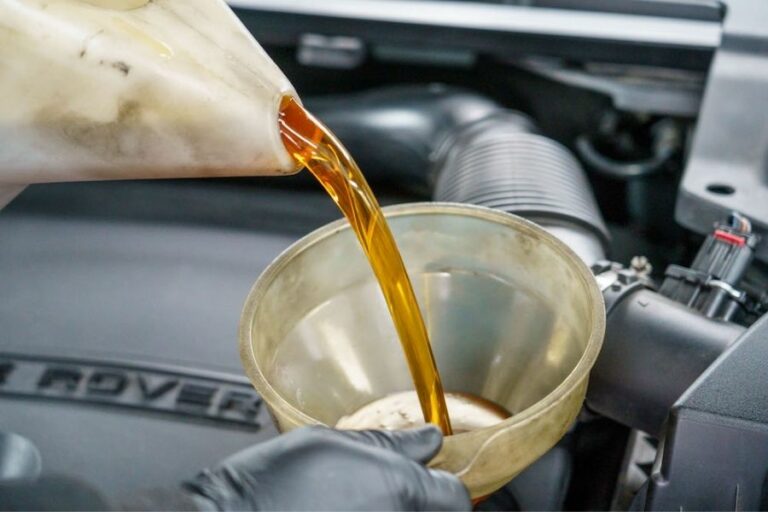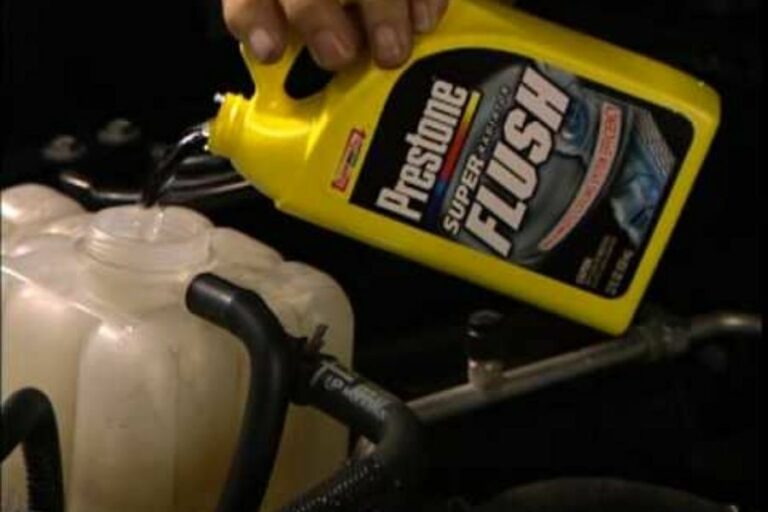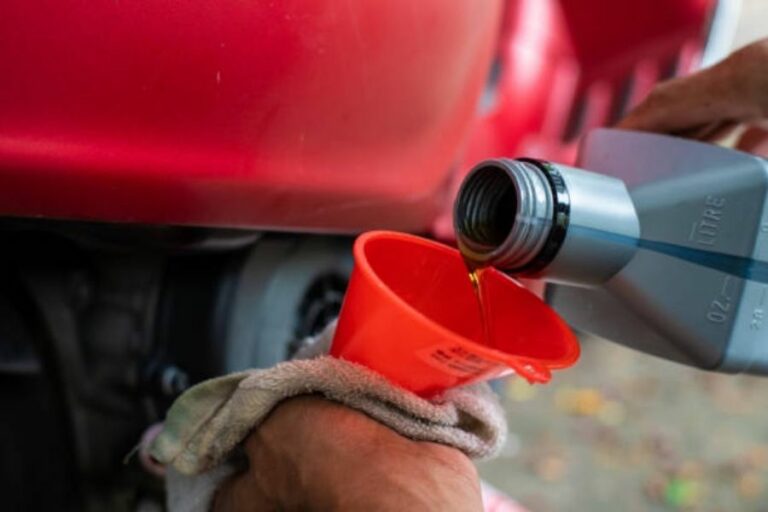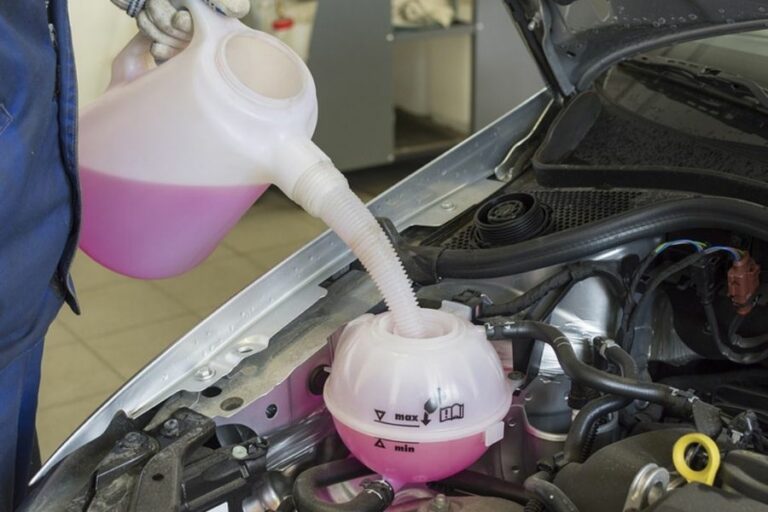Why My Car Leaking Fluid Front Passenger Side- 6 Reasons
Fluid leaks in your car aren’t that surprising at all. Several reasons might contribute to car leaking fluid front passenger side that you might be facing.
The spilled fluid can be from a leaky reservoir, a faulty gasket, or a heater core. That said, your vehicle requires immediate repairs when such leaks are from the front passenger side.
We’ll break down this problem and discuss the solution in this article. Therefore, stay with us till the end of this guide.
How to Identify a Car Leaking Fluid on the Front Passenger Side?
If you haven’t seen fluid leaks before, being unaware of the fluid types is expected.
Before going for any fix, you must identify the liquid type on the front passenger side. Almost all the major car fluid lines pass through this. The color would be the biggest hint to determine the exact fluid type.
The table below includes the color of the fluids with lines through the passenger side.
| Type of Fluid | Color |
| Water | Transparent |
| Engine Oil | Black/Brown |
| Coolants | Blue/Green |
| Gear Oil | Light/Dark Brown |
| Power Steering Oil | White |
| Transmission Oil | Black/Brown |
| Brake Oil | Yellow |
Read Also: How To Troubleshoot Brake Fluid Leaking From Rear Wheel?
Why is the Car Leaking Fluid From the Front Passenger Side?
The car leaking oil front passenger side indicate faulty or broken components in the adjacent area.
There can be loose hoses, broken seals, or even parts with leaks/cracks.
We have included the potential reasons for all types of fluid leaks on the front passenger side. Let us look at those:
1. Leaking Coolants
Coolants are vital elements that help keep your car engine temperature optimum. The coolant levels getting low will force your car to stop functioning.
If you ever notice a bluish-like fluid with a sweetening smell settling as puddles on the ground adjacent to the front passenger side, it might be an issue with coolant leakage as coolant lines pass through this section.
Several reasons contribute to the coolant leaks. Some of the common reasons are:
- Radiator cap or spring getting damaged
- The worn-out radiator tube was damaged due to debris and causing to leak
- Lower hose of the water pump getting defective
- Expansion tank has leaks
2. Engine Oil Spills
Engine oil spills are more prominent than coolant spills. Look at the reasons below to know why you may find the engine oil puddles on the car’s front passenger side.
- Oil pouring out due to overflowing of excessive oil than required
- Gasket holding oil is installed incorrectly
- Defects or defects in the valve seals
- Malfunctioning turbocharger
- Holes in the engine oil pan
Read Also: Yellow Fluid Leaking from Car
3. Transmission Fluid Spills
Transmission fluid leaks are harmful to the car, and since their fluid lines pass through the front passenger side, they are prone to leaks. The main reasons behind their leakage are listed below:
- Faulty or broken seals
- Worn-out or broken fluid lines
- Leaks in the oil transmission oil pan
4. Water Leaks
Water leaks on the front passenger side of your vehicle are a regular phenomenon. The reasons your car may have water leaks on the front side are listed below:
- Damaged stripping lines
- Clogged AC evaporator drain
- Leaks in AC evaporator
- Cracks in the windshield
5. Power Steering Fluid Leaks
The fluid leaking for smooth functioning of the power steering doesn’t happen too often. But specific faulty components around can invoke it. In this regard, some of the relevant reasons are as follows:
- Crack between the hoses
- Overfilled fluid in the reservoir
- Wrong fluid usage
- Worn-out power steering rack
6. Gear Oil Leaks
Like all the fluid types mentioned above, the reasons for gear oil leaks are similar. Let’s look at those for a better understanding:
- Uneven pressure in the gear that causes unusual heating up
- Inappropriate design of the reducer
- Excessive volume of oil
Read Also: Clear Fluid Leaking from Car
How to Fix a Car Leaking Fluid From the Front Passenger Side?
Most of the reasons mentioned above require extensive mechanical expertise to solve.
However, with limited resources and basic techniques, you can solve a few issues resulting in a fluid leak. Three methods you can try quickly are described in the section below:
Fixing Car Door Gaskets
The primary function of gaskets in the car door is to obstruct debris from entering. When the gasket becomes worn out, there is every possibility of leaks.
If your car has a torn gasket, there is nothing to worry about. The entire repairing process is very straightforward, which we will be breaking down in the steps below:
Step 1: Gather Materials
The initial step in the repair will involve a few tools and materials. Some of the essential tools in the procedure would be – scissors, tape, sealant and weatherstripping.
Step 2: Inspect the Door
You should look for signs of any damage or tear on the gasket before moving to the next step.
Step 3: Cut Torn Parts
With the scissors, you cut the damaged section of the gasket. Eventually, the process would clean the place for the new gasket.
Step 4: Attach New Gasket
Pick one door-end and then, with the adhesive or tape, work it around. Until you ensure a proper seal on all edges, try accordingly. If any gap remains, use silicone sealant to fill it.
Next, set up the weatherstripping on the gasket’s outer edge and ensure it will blend evenly with all the sides.
When each of the four steps is complete, the issue is solved. It is then safe to say that you have solved the fluid leaks on the front passenger side
Fix A/C Evaporator
The leak in the A/C evaporator might seem a tricky issue to fix. But we have a solution if you don’t want mechanic consultation for this problem.
In this regard, you can try the steps only if you have relevant knowledge about the vehicle. Let us look at the steps below:
- Step 1: Inspect Leak
Before starting any repair measures, you must locate and inspect for leaks in the evaporator. For this, your focus should be identifying the wet spots through visual inspection in the evaporator area.
- Step 2: Turn Off the Engine
Before starting the process on a full flow, you must cool down all the surrounding components. That is why you should turn the engine off and disconnect the opposing end of the battery.
- Step 3: Clear Coolant
This step will involve clearing all the existing coolant in the system. It is necessary for your safety as it imposes risks of toxic elements.
- Step 4: Take Out Evaporator Core
In this step, you must extract the evaporator core from its position. While doing this, you must ensure utmost safety as the component has delicate parts prone to damage.
- Step 5: Inspect the Core
You must carefully inspect the core and search for leaks or cracks. If you find any, replace the total unit and ensure it properly fits with a sealant.
- Step 6: Reconnect Evaporator Core
Install the evaporator core and reconnect all disconnected connections.
- Step 7: Refill the Coolant
Based on your car model and specs, refill the coolant with the correct volume.
Read Also: Green Fluid Leaking from Car: Everything You Need To Know
Replace the Radiator Hoses
Defective hoses will leak coolants on the front passenger side. But replacing these leaky hoses is an easygoing job. Look at the steps below to pull off this process:
- Step 1: Park Your Car
Firstly, you must park your vehicle on a flat surface. After that, turn off the engine and let the radiator cool down.
- Step 2: Unplug the Radiator Cap
In this step, you’ll need to take out the radiator cap and isolate it.
- Step 3: Drain Radiator
Place a pan under the radiator and drain it completely.
- Step 4: Undo the Clamps
Navigate the clamps to the ends of the hose and force the tension existing in the spring. The total unscrewing can also be done with the help of screwdrivers.
- Step 5: Take Out the Coolant Hose
Remove the coolant hose by bending and removing it from the fitting.
- Step 6: Fit New Hose
In place of the old option, and install the new hose. After that, position and tighten the clamps, ensuring firmness in the fitting.
- Step 7: Unscrew Radiator
Similarly, take out the radiator hose and replace it if needed.
- Step 8: Fill New Coolant
Take measures to fill the cooling system with new coolants by plugging the drain petcock.
How to Prevent a Car From Leaking Fluid From the Front Passenger Side?
The preventive measures for leaking fluid on the car’s front passenger side are always component specific. But you can generally adopt certain practices that help avoid these to a certain extent. Let’s have a look at those:
- Regularly inspect and change the oil filters
- Use the model-specific oil on certain components
- Don’t overfill the fluid or oil reservoir
- Inspect and carry out a routine checkup on crucial car parts
Read Also: Red Fluid Leaking from Car
FAQs.
Since the different types of fluids might leak on your front passenger side, it’s ok to get confused. To help you, we included some of the most asked queries by people facing this issue.
Is it ok to drive with a car fluid leak?
Driving with fluid leaks is dangerous in any situation. Oil leaks are especially dangerous as oil is a flammable component, and there are higher chances of fire hazards.
Is the car leaking water harmful to the engine?
Water leaks aren’t that harmful usually for the engine in particular. It’s maybe due to some condensation on the fluid lines, which you can fix easily. But coloured fluid leaks mean serious implications that need immediate measures.
Can fluid leak from the front cam seal?
It is possible to leak oil from the front cam seal when it’s loose. This seal covers a good portion of the engine block. Therefore, engine oil might leak from this side.

![Toyota Corolla Power Steering Fluid Type and Capacity [1992-2008]](https://carfluidpro.com/wp-content/uploads/Toyota-Corolla-Power-Steering-Fluid-768x512.jpg)




